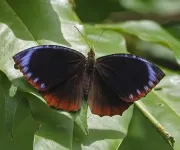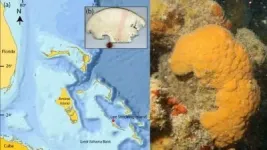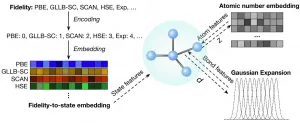(Press-News.org) Philadelphia, January 14, 2021--Based on preclinical studies of an investigational drug to treat peripheral nerve tumors, researchers at Children's Hospital of Philadelphia (CHOP) as part of the Neurofibromatosis Clinical Trials Consortium have shown that the drug, cabozantinib, reduces tumor volume and pain in patients with the genetic disorder neurofibromatosis type 1 (NF1). The results of the Phase 2 clinical trial, co-chaired by Michael J. Fisher, MD at CHOP, were published recently in Nature Medicine.
"This is the second class of drugs to demonstrate a very promising response rate for NF1 patients with these tumors," said first author Fisher, Chief of the Section of Neuro-Oncology and Director of the Neurofibromatosis Program at CHOP, and Group Chair for the NF Clinical Trials Consortium, which includes 25 sites developing innovative biologically-based clinical trials for complications of NF. "Collectively, the data presented in this study illustrate a true bench-to-bedside approach, coordinating translational and clinical efforts to advance targeted therapies for a rare disease like NF1."
NF1 is a rare tumor predisposition syndrome, affecting approximately 1 in 3000 people worldwide. The condition involves the proliferation of tumors throughout the central and peripheral nervous system. One of the most prevalent type of tumors in NF1 are plexiform neurofibromas (PN), multicellular tumors composed of tumorigenic Schwann cells, fibroblasts, perineural cells, macrophages, mast cells, and secreted collagen. The tumors arise within nerves, affect up to half of patients with NF1, grow rapidly during childhood, and can lead to motor and sensory dysfunction, pain, and disfigurement. When the tumors impinge on vital structures like the airway or the spinal cord, they can be life-threatening, and although the tumors are not malignant, they can become so over time.
Because chemotherapy and radiation are ineffective at treating these tumors, surgery is the current standard of care. However, given that the tumors can be intertwined with nerves and other vital structures, surgery is often not possible. Recent studies have shown that a MEK inhibitor called selumetinib can be an effective treatment in some children with NF1-related PNs, but not all patients respond to this treatment, so there is a need for more treatment options.
Based on preclinical studies of cabozantinib, a tyrosine kinase inhibitor that targets both the tumorigenic Schwann cells in PNs as well as the complex tumor microenvironment, the researchers enrolled patients in a single arm, multicenter Phase 2 clinical trial. Twenty-three patients between the ages of 16 and 34 enrolled in the trial; twenty-one were evaluable for drug toxicity and 19 were evaluable for their response to the treatment. Of the 19 patients studied for response, eight (42%) had a partial response, defined as having greater than a 20% decrease in tumor volume, and 11 had stable disease after 12 rounds of treatment. No patient had disease progression while participating in the trial. The eight patients who had a partial response to treatment also reported a significant reduction in tumor pain intensity and pain interference in daily life.
Patients enrolled in the trial reported several adverse events, including diarrhea, nausea, asymptomatic hypothyroidism, fatigue, and palmar plantar erythrodysesthesia, a condition that causes redness, swelling, and pain on the palms of the hands and/or the soles of the feet. However, none of the side effects were reported as being severe.
Based on the benefit of cabozantinib demonstrated in this study, the NF Clinical Trials Consortium opened a pediatric cohort as well, enrolling patients ages 3 to 15. Enrollment is complete, and the study is ongoing.
"It's incredibly exciting that we now have two classes of drugs that result in tumor responses, given that we had no promising agents only a few years ago," Dr. Fisher said. "However, despite this excitement, neither cabozantinib nor MEK inhibitors shrink all tumors or make them go away completely. Therefore, we are building on these results as well as ongoing laboratory studies and are planning future exploration of combination therapies, so that we can further improve outcomes for these patients with these debilitating and life-threatening tumors."
INFORMATION:
The research was supported by an NF Clinical Trials Consortium award from the Department of Defense NF Research Program (W81XWH-12-1-0155), a Developmental and Hyperactive Ras Tumor SPORE funded through the NIH/NCI (U54- CA196519-04), and Exelixis.
Fisher et al. "Cabozantinib for neurofibromatosis type 1-related plexiform neurofibromas: a phase 2 trial," Nature Medicine, January 13, 2021, DOI: 10.1038/s41591-020-01193-6
About Children's Hospital of Philadelphia: Children's Hospital of Philadelphia was founded in 1855 as the nation's first pediatric hospital. Through its long-standing commitment to providing exceptional patient care, training new generations of pediatric healthcare professionals, and pioneering major research initiatives, Children's Hospital has fostered many discoveries that have benefited children worldwide. Its pediatric research program is among the largest in the country. In addition, its unique family-centered care and public service programs have brought the 595-bed hospital recognition as a leading advocate for children and adolescents. For more information, visit http://www.chop.edu
Many animal and insect species use Batesian mimicry - mimicking a poisonous species - as a defense against predators. The common palmfly, Elymnias hypermnestra (a species of satyrine butterfly), which is found throughout wide areas of tropical and subtropical Asia, adds a twist to this evolutionary strategy: the females evolved two distinct forms, either orange or dark brown, imitating two separate poisonous model species, Danaus or Euploea. The males are uniformly brown. A population group is either entirely brown (both males and females) or mixed (brown males and orange females).
City College of New York entomologist David Lohman and his collaborators studied the genome of 45 samples representing 18 subspecies across Asia to determine ...
While new research from West Virginia University economists finds that presidential inaugurations have gained popularity as must-see tourist events in recent years, major security threats will keep visitors away for the inauguration of President-Elect Joe Biden.
Published in "Tourism Economics," the study, by Joshua Hall, chair and professor of economics, and economic doctoral student Clay Collins, examined the impact of the inaugurations of Barack Obama and Donald Trump on hotel occupancy in the Washington, D.C.-area.
Daily occupancy rates around the inaugurations were four-to-six times higher than the next largest event in the sample. The research team also concluded ...
To achieve full occupancy, hotels used to rely exclusively on experience, concentration and human abilities. Then came online booking, which made the reservation collection process faster, but did not solve the risk of turning down long stays because of rooms previously booked for short stays.
To avoid overbooking (accepting more reservations than there is room for) in some cases online sales are blocked before hotels are completely booked. The solution that the University of Trento has just discovered could change the life of hotels by increasing the number of occupied rooms and, therefore, in the revenue of hotel owners.
For an average Italian hotel (50 rooms), ...
More than half of all university students in the United States have experienced high levels of psychological impact from the COVID-19 pandemic, according to a new study published in the open-access journal PLOS ONE by Matthew Browning of Clemson University, US, and colleagues.
University students are increasingly recognized as a psychologically vulnerable population, suffering from higher levels of depression, anxiety, substance abuse and disordered eating compared to the general population. Moreover, college students have been among the most strongly affected by COVID-19 because of uncertainty regarding academic success, future careers and social life during college, among other concerns.
In the new study, researchers collected data on 2,534 students ...
Investors who bet on tropical forest conservation and reforestation to solve global warming by storing carbon in wood face huge uncertainties because the science behind predicting carbon stocks is still shaky. Even the best Earth Systems Models fail to predict how carbon stored by tropical forests varies from place to place. The New Phytologist invites scientists doing the "most-exciting, ground-breaking research" to review timely topics in a way that non-scientists can understand. Helene Muller-Landau, staff scientist at the Smithsonian Tropical Research Institute (STRI) was chosen to write the authoritative Tansley Review ...
MIAMI--Scientists used a 600-year-old marine sponge to reconstruct a record of ocean temperature in the North Atlantic revealing past volcanic activity as well as the current global warming trend from the release of carbon dioxide and other heat trapping gasses into Earth's atmosphere and absorbed by the oceans.
The University of Miami (UM) Rosenstiel School of Marine and Atmospheric Science-led research team used geochemical proxies to reconstruct a 600 year-long record of Atlantic Ocean temperatures from the skeleton of a sclerosponge (Ceratoporella nicholsoni).
The basketball-sized sclerosponge was ...
These findings validate the significance of the previously described first threshold - the point when the damage to the acinar cells of the pancreas is sufficient to trigger the infamous inflammatory cascade (Barreto and Saccone, 2010) - while highlighting the importance of a second threshold, namely the point when a person develops clinical symptoms of the disease sufficient to warrant going to hospital.
"This transcontinental collaboration of pancreatologists drew on their vast clinical and research experience spanning decades investigating the pathophysiology and treatments ...
Deep in the Brazilian Amazon River basin, scientists led by the Smithsonian's National Museum of Natural History fish research associate C. David de Santana discovered a small, river-fed lake filled with more than 100 adult electric eels, many of which were upwards of 4 feet long. On its own, this was an intriguing discovery, electric eels--a type of knifefish rather than true eels--were thought to be solitary creatures.
But in this lake along the banks of the Iriri River in Brazil's state of Pará, the researchers witnessed the eels working together to herd small fish called tetras into tightly packed balls. Then groups of up to ...
Underwater seagrass meadows may trap, extract and carry marine plastic debris to shore, thereby helping to remove plastic litter from the sea, according to a study published in Scientific Reports.
Previous research suggested that most plastics end up in the seafloor and that some are washed back to shore; however, how this occurs was unclear.
Seagrass meadows are widespread in shallow coastal waters and are involved in trapping and binding sediment particles that form the seabed. To assess the role that seagrass may have in trapping and removing marine plastic, Anna Sanchez-Vidal and colleagues measured the amount of plastic debris collected from seagrass litter ...
Advancements in energy technologies, healthcare, semiconductors and food production all have one thing in common: they rely on developing new materials--new combinations of atoms--that have specific properties enabling them to perform a needed function. In the not-too-distant past, the only way to know what properties a material had was by performing experimental measurements or using very expensive computations.
More recently, scientists have been using machine learning algorithms to rapidly predict the properties that certain arrangements of atoms would have. The challenge with this approach is it requires a lot of highly accurate data to train the model, which often does not exist.
By combining large ...






